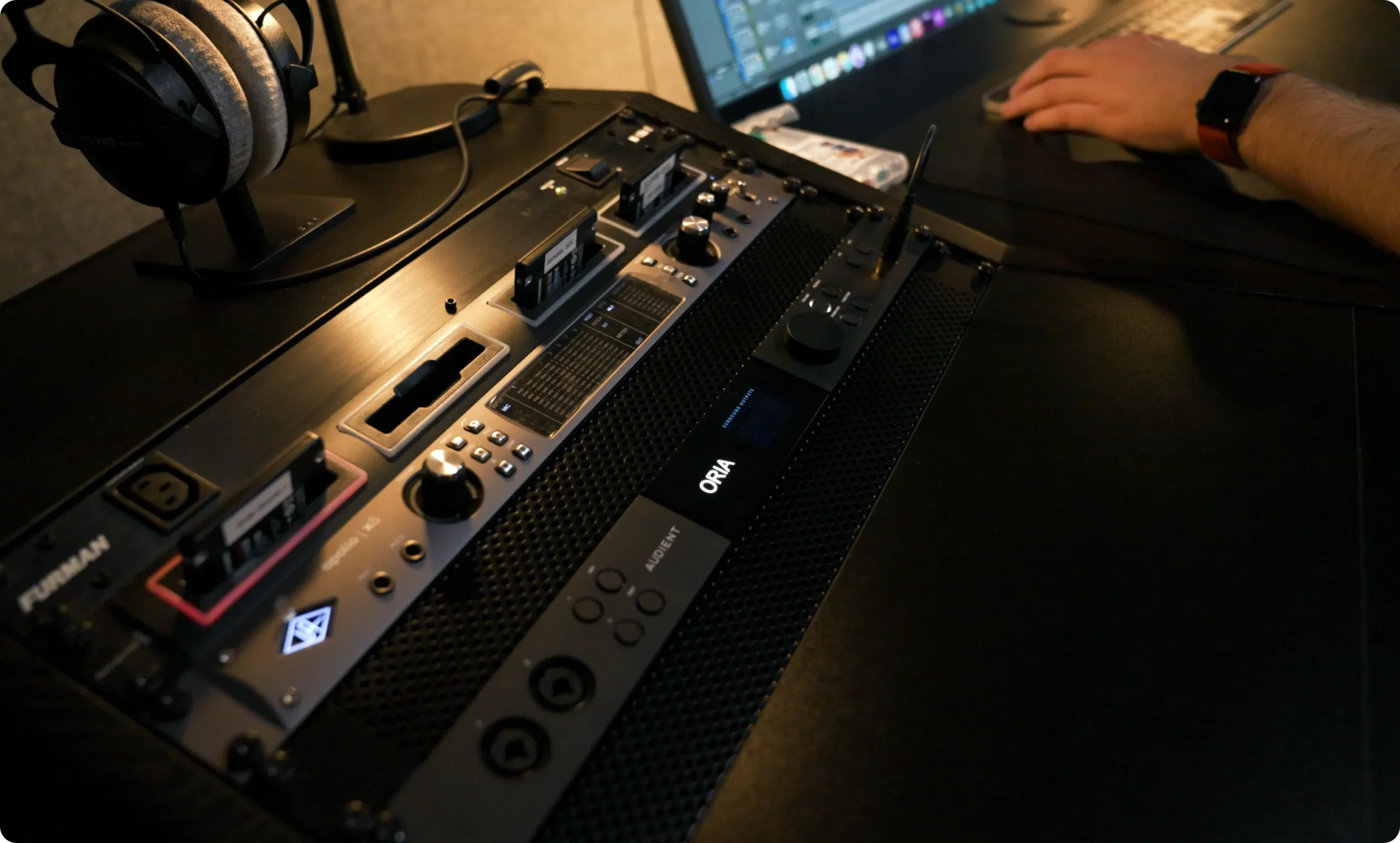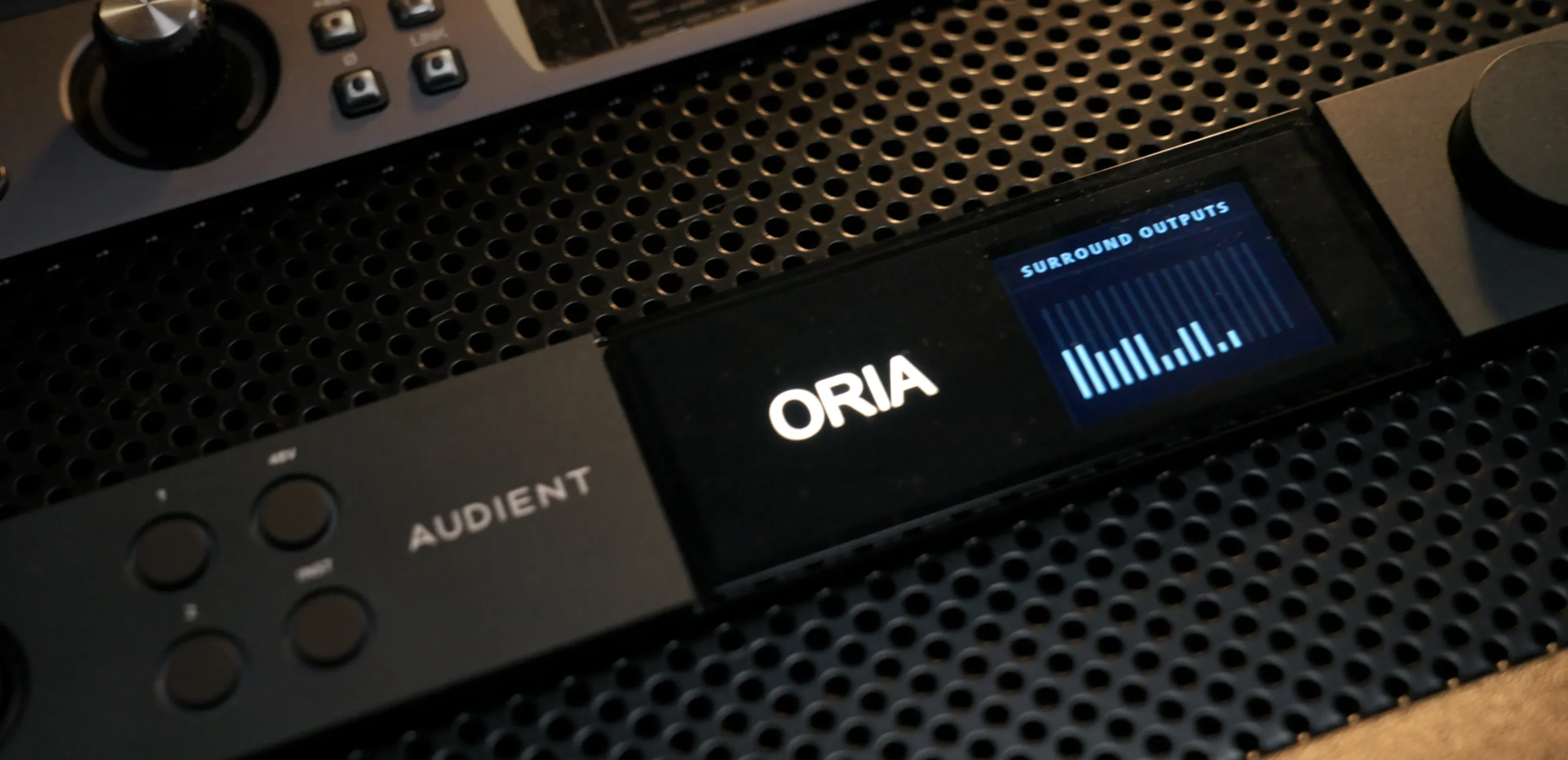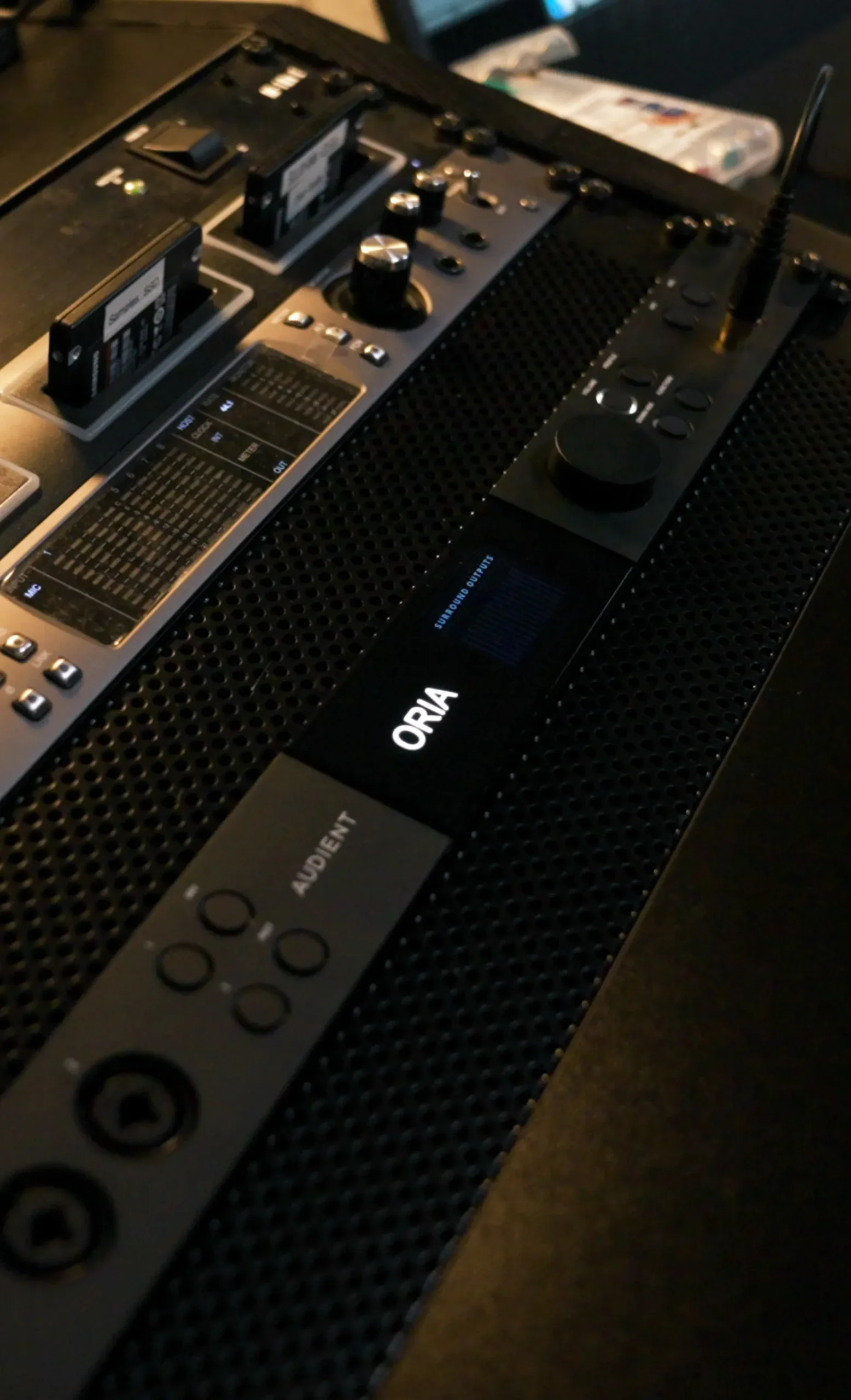
Creating Stories Through Sound
SODA-SOUND: ORIA CASE STUDY
SODA-SOUND is a full-service audio production studio based in Liverpool working with clients all across the globe. A fully certified Dolby Atmos studio, they have wooed brands such as Apple, Mercedes and SKREAM, Dua Lipa, Stella McCartney and Samsung. They’ve been mixing, mastering and designing sound for a broad range of industries spanning music, gaming and film to advertising. Today at least 90 percent of SODA-SOUND’s work leaves with an immersive mix.
SODA-SOUND founder, Ted White has previously described ORIA as “a groundbreaking tool” and “not just another piece of equipment [but] the solution many of us didn’t realise we were waiting for.”
Here Ted tells Audient more about how installing ORIA has made a huge difference to the way they work.

The Company
At SODA-SOUND we have been mixing in Atmos for several years now and have worked on over 8000 spatial mixes to date. We are always actively looking out for new and exciting technology and gear in the industry that will allow us to do our job more efficiently and get the best possible results.
As we work daily between Stereo and Atmos we needed a system that could manage this continuous back and forth workflow. We ended up adopting a system that also came around as an adaptation of our stereo workflows, which included using multiple interfaces and linking them via ADAT. This became quite a common theme as most interfaces on the market were limited to 8 analogue outputs and we’d need at least 12 for our first Atmos setup. We had to create a robust quality checking method to ensure the mixes translated well across all systems, and like most studios, once we found something that gave repeatable and reliable results we stuck to what was working.
Before ORIA
What were you looking to solve?
We were always keen to try and integrate our additional Stereo Speaker set up into our Atmos Suites A & B but every work around would have included aggregate devices, alternate routing or in some instances a totally new interface and speaker addition to the system. Nothing was streamlined enough, and there wasn’t a product offering this all in one package.
“With ORIA […] I know I can bring [the mix that Ted has mastered in his room] in here and we’re both hearing the same things” ~ Joe Punter
Spatial Mix Engineer
Did you know you were looking for ORIA?
In a strange way, yes. We were waiting for the right product to come out that would solve our problems. Atmos in music has really gained popularity in recent years and there has been a surge in mixing and mastering engineers getting involved in the Atmos format. It was only going to be a matter of time before a product hit the scene that could do it all in one product and that happened to be ORIA!
We were looking for solutions and a work around, but we were coming back to the system we had in place as being the best for what we needed. When the ORIA was revealed, that’s when we got really excited about what Audient had made and we haven’t looked back since.
Initial Expectations
Upon unboxing the ORIA, its design commands attention. The unit, with its matte black finish and intuitively designed interface, signals a departure from the makeshift setups of the past. It’s clear that Audient has placed a significant emphasis on both form and function, making the ORIA not only a visually appealing piece of gear but also a highly functional one. The inclusion of features such as two headphone outputs and combi jack mic inputs speaks to its versatility and readiness to handle a variety of studio tasks.
One of the standout aspects is its integration capability with Sonarworks for immersive room correction. This is a game-changer, allowing for precise calibration of Atmos and stereo speakers within the same space. The ORIA’s software further impresses with its ability to solo channel pairs, enhancing the spatial analysis of mixes—an essential tool for any serious mix engineer.

How did ORIA work for SODA-SOUND?
Setting Up
The setup process was surprisingly (often not the case for brand-new solutions) straightforward, integrating seamlessly with existing studio components. Opting to position the ORIA as the primary interface, we were able to streamline our workflow significantly. The ORIA’s flexibility shone through its ability to swap between DAWs and sample rates without a hitch, illustrating its strength as a monitor controller in a dynamic studio environment.
“When we switch to stereo I know I can trust everything I’m hearing” ~ Alistair Ford
Spatial Mix Engineer
Were there obvious changes that were needed in your workflow?
When we got the ORIA plugged in, we were actually most impressed at the reduction of steps in our workflow. Implementing the ORIA meant we could now get in session, and spatialise a project much quicker with no glitches or forced actions to get things working. We can honestly say we’ve never used an interface that is so able to jump between sessions across multiple DAWs and not have issues along the way. I would say that ORIA has actually increased our productivity most in this sense, our down time between jobs is now virtually nothing as session hopping has just become a non-issue with the ORIA!
Beyond Setup: Real-World Applications
The ORIA shines across a broad spectrum of audio projects, proving itself invaluable in both music mixing and post-production. One particularly notable application was in mastering long-form meditation music for Atmos, where the ORIA facilitated a seamless workflow between stereo and immersive formats. This not only saved time but also ensured consistency across deliverables, a critical factor in professional audio production.
The device’s contribution to creativity cannot be overstated. By reducing the time spent on troubleshooting and setup, the ORIA allows more time for the creative process—a win for any audio professional.

Final Thoughts
For anyone immersed in Dolby Atmos mixing or considering it, the Audient ORIA is an indispensable tool. Its dedicated design for immersive audio, coupled with the capability for seamless stereo integration, positions it as a must-have for professionals seeking to expand their sonic landscapes.
“What used to be quite convoluted and complicated has now been made incredibly easy” ~ Ted White
Founder of SODA-SOUND & Spatial Mix Engineer
The ORIA stands out not just for its innovative features but also for its ability to make Atmos mixing more accessible and efficient, setting a new standard in audio production equipment. It’s a testament to Audient’s commitment to pushing the boundaries of what’s possible in sound.

Creating Stories Through Sound
SODA-SOUND: ORIA CASE STUDY
Website: soda-sound.com
Instagram: @sodasoundmusic
SODA-SOUND is a full-service audio production studio based in Liverpool working with clients all across the globe. A fully certified Dolby Atmos studio, they have wooed brands such as Apple, Mercedes and SKREAM, Dua Lipa, Stella McCartney and Samsung. They’ve been mixing, mastering and designing sound for a broad range of industries spanning music, gaming and film to advertising. Today at least 90 percent of SODA-SOUND’s work leaves with an immersive mix.
SODA-SOUND founder, Ted White has previously described ORIA as “a groundbreaking tool” and “not just another piece of equipment [but] the solution many of us didn’t realise we were waiting for.”
Here Ted tells Audient more about how installing ORIA has made a huge difference to the way they work.

The Company
At SODA-SOUND we have been mixing in Atmos for several years now and have worked on over 8000 spatial mixes to date. We are always actively looking out for new and exciting technology and gear in the industry that will allow us to do our job more efficiently and get the best possible results.
As we work daily between Stereo and Atmos we needed a system that could manage this continuous back and forth workflow. We ended up adopting a system that also came around as an adaptation of our stereo workflows, which included using multiple interfaces and linking them via ADAT. This became quite a common theme as most interfaces on the market were limited to 8 analogue outputs and we’d need at least 12 for our first Atmos setup. We had to create a robust quality checking method to ensure the mixes translated well across all systems, and like most studios, once we found something that gave repeatable and reliable results we stuck to what was working.
Before ORIA
What were you looking to solve?
We were always keen to try and integrate our additional Stereo Speaker set up into our Atmos Suites A & B but every work around would have included aggregate devices, alternate routing or in some instances a totally new interface and speaker addition to the system. Nothing was streamlined enough, and there wasn’t a product offering this all in one package.
“With ORIA […] I know I can bring [the mix that Ted has mastered in his room] in here and we’re both hearing the same things” ~ Joe Punter
Spatial Mix Engineer
Did you know you were looking for ORIA?
In a strange way, yes. We were waiting for the right product to come out that would solve our problems. Atmos in music has really gained popularity in recent years and there has been a surge in mixing and mastering engineers getting involved in the Atmos format. It was only going to be a matter of time before a product hit the scene that could do it all in one product and that happened to be ORIA!
We were looking for solutions and a work around, but we were coming back to the system we had in place as being the best for what we needed. When the ORIA was revealed, that’s when we got really excited about what Audient had made and we haven’t looked back since.
Initial Expectations
Upon unboxing the ORIA, its design commands attention. The unit, with its matte black finish and intuitively designed interface, signals a departure from the makeshift setups of the past. It’s clear that Audient has placed a significant emphasis on both form and function, making the ORIA not only a visually appealing piece of gear but also a highly functional one. The inclusion of features such as two headphone outputs and combi jack mic inputs speaks to its versatility and readiness to handle a variety of studio tasks.
One of the standout aspects is its integration capability with Sonarworks for immersive room correction. This is a game-changer, allowing for precise calibration of Atmos and stereo speakers within the same space. The ORIA’s software further impresses with its ability to solo channel pairs, enhancing the spatial analysis of mixes—an essential tool for any serious mix engineer.

How did ORIA work for SODA-SOUND?
Setting Up
The setup process was surprisingly (often not the case for brand-new solutions) straightforward, integrating seamlessly with existing studio components. Opting to position the ORIA as the primary interface, we were able to streamline our workflow significantly. The ORIA’s flexibility shone through its ability to swap between DAWs and sample rates without a hitch, illustrating its strength as a monitor controller in a dynamic studio environment.
“When we switch to stereo I know I can trust everything I’m hearing” ~ Alistair Ford
Spatial Mix Engineer
Were there obvious changes that were needed in your workflow?
When we got the ORIA plugged in, we were actually most impressed at the reduction of steps in our workflow. Implementing the ORIA meant we could now get in session, and spatialise a project much quicker with no glitches or forced actions to get things working. We can honestly say we’ve never used an interface that is so able to jump between sessions across multiple DAWs and not have issues along the way. I would say that ORIA has actually increased our productivity most in this sense, our down time between jobs is now virtually nothing as session hopping has just become a non-issue with the ORIA!
Beyond Setup: Real-World Applications
The ORIA shines across a broad spectrum of audio projects, proving itself invaluable in both music mixing and post-production. One particularly notable application was in mastering long-form meditation music for Atmos, where the ORIA facilitated a seamless workflow between stereo and immersive formats. This not only saved time but also ensured consistency across deliverables, a critical factor in professional audio production.
The device’s contribution to creativity cannot be overstated. By reducing the time spent on troubleshooting and setup, the ORIA allows more time for the creative process—a win for any audio professional.

Final Thoughts
For anyone immersed in Dolby Atmos mixing or considering it, the Audient ORIA is an indispensable tool. Its dedicated design for immersive audio, coupled with the capability for seamless stereo integration, positions it as a must-have for professionals seeking to expand their sonic landscapes.
“What used to be quite convoluted and complicated has now been made incredibly easy” ~ Ted White
Founder of SODA-SOUND & Spatial Mix Engineer
The ORIA stands out not just for its innovative features but also for its ability to make Atmos mixing more accessible and efficient, setting a new standard in audio production equipment. It’s a testament to Audient’s commitment to pushing the boundaries of what’s possible in sound.


Atmos just got easy
Meet ORIA, the world’s first audio interface and monitor controller designed specifically with immersive audio in mind. Built for creating immersive audio mixes for formats such as Dolby Atmos, ORIA lets you calibrate, control and monitor multi-channel speaker arrays from stereo up to 9.1.6 and everything in between. Perfect for music, film, TV, game and VR production.


Atmos just got easy
Meet ORIA, the world’s first audio interface and monitor controller designed specifically with immersive audio in mind. Built for creating immersive audio mixes for formats such as Dolby Atmos, ORIA lets you calibrate, control and monitor multi-channel speaker arrays from stereo up to 9.1.6 and everything in between. Perfect for music, film, TV, game and VR production.
